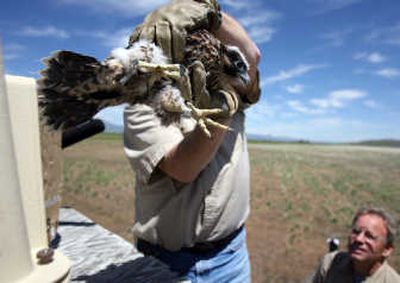Peregrine falcons get a new home

FAIRFIELD, Idaho – Four baby peregrine falcons, all squawking nonstop, were released on the Camas Prairie by state biologists in hopes they find the vast southern Idaho habitat suitable enough to call home.
The young raptors were released Monday under the supervision of the Idaho Department of Fish and Game as part of an experiment to populate the prairie that stretches from Twin Falls to Sun Valley. Biologists released the 35-day-old female chicks in the prairie’s Centennial Marsh section.
For some reason, biologists say, the falcons, whose air speeds have been clocked at 260 mph, have not yet settled in the prairie.
“Generally, you have to release 20 at a site before a pair comes back,” said Bruce Haak, a regional biologist with Fish and Game.
The peregrines freed this week bring the total released at the site in the past five years to 21.
The nation’s peregrine population was in decline in the 1970s, and by 1975 the raptor had vanished from Idaho, Haak said. After successful efforts by the Idaho-based Peregrine Fund, which released 4,000 birds nationwide, the bird was taken off the endangered species list in 1999.
Idaho is home for about three dozen pairs of peregrines, at least in spring and summer. Haak said peregrine means “wanderer,” and the falcons live up to their name, cruising around the nation and into Mexico.
Many falcons prefer to nest in high cliffs in the wild, though some choose man-made habitats, including downtown Boise, where one pair has set up a permanent home in one of the city’s taller buildings.
The chicks will stick around a wooden box atop a 20-foot tower until they master flying and hunting skills. Terry Gregory, the Fish and Game habitat biologist at Centennial Marsh, will feed quail to the young birds until August when they are ready to leave the box.
Each is fitted with a tiny radio transmitter so Gregory can track their movement, particularly if they stray too far from the man-made nests while testing their wings.
“I always say they’re like a 15-year-old in a Ferrari,” said Gregory, whose house overlooks a stretch of the prairie.
“They fly fast, but they don’t know how. They don’t know what to do with their speed,” he said.
Peregrines are the fastest animals in the world, and when they begin flying in about a week, Gregory said he expects to see them dive toward and miss their intended perches.
“They’re fun to watch,” he said. “You’ll see all four of them in the air playing, zooming, swooping, being kids.”